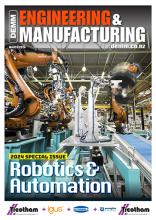This year’s International Women’s Day (IWD) follows the theme of “embracing equity” — focusing on giving fair opportunities for everyone to succeed. As a business invested in its people, leader in metal cutting, Sandvik Coromant, highlights the experience of Sandvik Coromant President, Helen Blomqvist.
One of IWD’s key missions is to forge inclusive work cultures where women’s careers thrive and their achievements are celebrated. This year, the campaign centres around equity and how providing equal opportunities is no longer enough. So how do we achieve equity?
At Sandvik Coromant, the number of females in functional management roles currently sits at 43%. This is above the estimated industry average, which is considered to be 38%, according to the Chartered Management Institute (CMI). However, if we’re to look across the manufacturing industry, it’s clear there’s still a lot to be done to truly achieve equity. A recent report by the Manufacturing Institute found that females make up just 29% of the manufacturing workforce.
Staggeringly, it also finds that 63% of women struggling to get into the field face challenges due to the sector’s lack of flexibility and almost half are deterred due to childcare issues, compared to just 8% of males.
It seems, therefore, that females wanting to succeed in the manufacturing industry still face challenges that rarely affect their male counterparts. If the industry is to truly reach equity, it must be aware of the unconscious bias certain groups face and find ways of managing that bias. But first, businesses must realise that hiring diversly does not just help fulfil a quota. In fact, it can bring real, measured business benefits.
Time to act
According to a Wall Street Journal report examining diversity and inclusion among S&P 500 companies, "diverse and inclusive cultures are providing companies with a competitive edge over either peers". What’s more, a pre-pandemic McKinsey report Delivering Through Diversity showed companies in the top quartile of their rankings for successful gender diversity on their executive teams were 21% more likely to have above-average profitability. For ethnic and cultural diversity, that figure was 33%.
Despite efforts to increase diversity, many businesses still aren’t doing enough. In January 2023, Gartner published a survey detailing the top five challenges facing diversity, equity and inclusion (DEI) leaders. The survey finds that over half of DEI leaders fail to take responsibility for driving diverse outcomes, while a third feel they don’t have the power to make real change.
It’s clear that businesses have to take strides to truly reap the benefits of diverse teams. One way of inspiring a more balanced working environment is to promote the voices of those already in the industry. Sandvik Coromant spoke to its president, Helen Blomqvist.
Meet the president
After starting as a research engineer at Sandvik Coromant 20 years ago, it’s safe to say Helen Blomqvist has risen through the ranks successfully after becoming the company’s president in 2020. Many experiences have shaped Helen’s experience as an engineer — and everything she’s achieved has been a learning opportunity. “I like to see feedback as a gift, rather than a criticism. I never stop learning, and everyone at Sandvik Coromant can teach me something,” she explained.
“To provide fair and equal opportunities for all members of the organisation, it’s important we’re continuously learning how we can do better. At Sandvik Coromant, we have a regular feedback system where employees can anonymously voice how they’re feeling in their role. From our most recent survey, we’ve found that 82% of respondents feel they can be themselves at work, while 83% say they feel proud to work at Sandvik Coromant. Those are good figures, but there’s always room to do better.”
A believer that a learning culture feeds curiosity and sparks innovation, providing the opportunity to develop one’s skills and nurture personal development is important to Helen. “A big part of delivering equity is providing opportunity for development and making sure everyone feels confident, successful and happy at work,” she adds.
“There was an initiative at Google called 20% time, which I’ve always admired. “The scheme meant that, for a portion of a workers’ week, they could dedicate their time to exploratory work, focusing on creativity and learning that was outside of their normal responsibilities. It’s where Google Mail was born, among many other landmark creations.
“While I don’t invest quite so much time into other activities, I try to lead by example and dedicate 90 minutes of my time each week to my own learning. Whether it's attending a training session or speaking to one of our product experts, there’s always something new for me to learn. Of course, fostering this learning culture isn’t the only way to achieve equity in a workplace — and actions will always speak louder than words. However, being able to create that space for development, at a rate that’s flexible to each individual and that plays to their own strengths plays a huge role in creating a more diverse workforce.”
The facts speak for themselves — industry must do more to encourage women to enter the manufacturing field. Celebrations such as IWD play a key part in showcasing the options available for women, who must not be held back by stereotypes. But, perhaps more importantly, sharing the stories of women in the industry who have overcome hurdles and developed true industry innovations is key to forming the next generation of manufacturing heroes.






